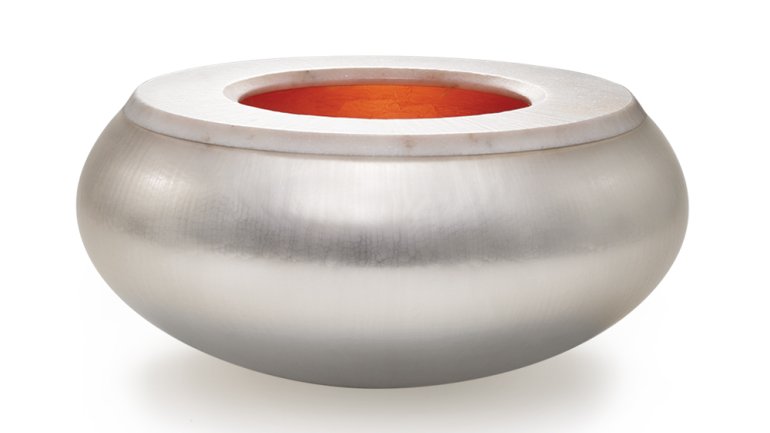Part of the Process
Part of the Process
Granite Calimpong had his hands in clay – until the hot shop called his name.
Growing up, Granite Calimpong was surrounded by handmade objects. His father, a potter, stocked the cupboards with his own ceramic cups and plates, as well as those by other artists, and he filled the house with works from fellow artists he knew.
“From a very young age, I was very aware of the functionality of things,” Calimpong, 32, says. Now an active member of Seattle’s thriving glass scene, Calimpong worked with clay into his 20s and still returns about once a year to Ferndale, California – population 1,400 – to assist his father in a semi-annual kiln firing.
How did he turn to glass? Even after a decade in the medium, the way Calimpong talks about the transition sounds a lot like someone describing the moment they met their soul mate.
The setting is San Diego, where Calimpong studied computing in the arts at the University of California and worked with ceramics on the side at the UCSD Crafts Center. He would frequently catch himself watching the glass artists. “The heat, and the event of it, really reminded me of wood-firing,” he says. His roommate began taking glassblowing classes, and when he brought home a beautiful cup he’d made with the help of an instructor, Calimpong signed up. He was hooked.
After college, Calimpong moved to Seattle. There, he apprenticed with Benjamin Moore, served as a poleturner at Pilchuck Glass School, and gradually began working with as many artists as he could, absorbing all they had to teach. Today, he balances paying gigs, mostly as a freelance glassblowing assistant for familiar names in the field – from Moore and Dan Dailey to Janusz Pozniak and Ethan Stern – with his own work. He creates in a space he shares with his wife, Jenny Wittlinger, a graphic designer and letterpress printer, and three other makers, as the 5416 artist collective.
That “event” factor – the tight-knit team focused on a single goal, unable to step away until the work is finished – continues to inspire him. “There’s
a certain amount of cooperation and teamwork that you really have to give yourself up to on a lot of big projects,” he says. “In clay, in the scale I was working in, it can be a pretty solitary endeavor. In glass, for the most part, it’s a team effort – especially on a lot of the larger projects I end up working on in Seattle – and I really like that.”
All those years with clay do inform his work with glass, however, especially in the realms of proportion, form, and functionality. His sculptural works are minimalist and inventive, with strong features and playful shapes that are often reminiscent of ceramics. He also makes goblets and glasses, which are classical in inspiration, but modern, too, in their restraint.
The cups are “not a very marketable item,” he admits, though he loves making them to use and give to friends. “The way I usually think about it is I’m studying form and proportion on a small scale” – on an everyday, functional level.
As in his childhood home, Calimpong and Wittlinger have filled their home with handmade objects. Over the course of several years at Pilchuck, where he has been a student, a teaching assistant, an artist’s assistant, and, most recently, an instructor, he has traded his work for prints and paintings, as well as glass and clay. The couple also has two sets of dinnerware made by a friend, ceramist Anderson Bailey, that they use every day. And they have
a “really massive” collection of cups and bowls – large enough that they have to be deliberate about it, Calimpong says.
“Jenny and I always sort of gravitate toward certain bowls and cups,” he explains, “and that is a lot of fun for us – we’re always using things and then talking about whether we like this one or we don’t.” New additions are used once or twice, and if an item isn’t loved, “it goes right back out, because we have a lot of stuff in there.”
One of his goals for the near future is to spend more time on his own work. “I don’t want to stop working for the other artists I work for,” Calimpong says, which is easy to understand. “But I do want to try to find new ways to work with the material. That’s what always keeps me going back to the studio – always finding something new.”
Danielle Maestretti, a frequent contributor to American Craft, lives in Oakland, California.

